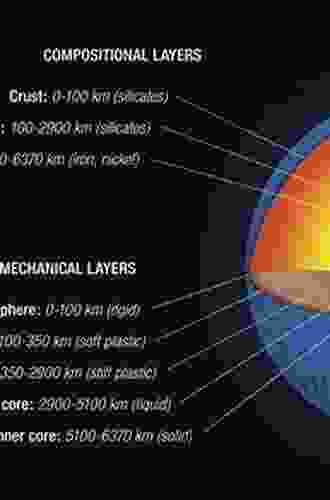Phase Diagrams for Geoscientists: A Comprehensive Guide to Understanding Phase Behavior in Geological Systems

Phase diagrams are graphical representations of the thermodynamic conditions under which different phases of a substance can coexist in equilibrium. They are essential tools for understanding the behavior of geological systems, such as the formation of minerals, the behavior of fluids in the Earth's crust, and the evolution of magmatic systems.
4.5 out of 5
| Language | : | English |
| File size | : | 50731 KB |
| Text-to-Speech | : | Enabled |
| Enhanced typesetting | : | Enabled |
| Print length | : | 716 pages |
| Screen Reader | : | Supported |
Types of Phase Diagrams
There are many different types of phase diagrams, depending on the number of components and phases involved. The most common type of phase diagram is the binary phase diagram, which shows the phase behavior of a system with two components. Ternary phase diagrams show the phase behavior of a system with three components, and so on. Other types of phase diagrams include pressure-temperature (P-T) diagrams, which show the phase behavior of a system as a function of pressure and temperature, and compositional phase diagrams, which show the phase behavior of a system as a function of the composition of the components.
Applications of Phase Diagrams
Phase diagrams are used in a wide variety of geoscience applications, including:
- Petrology: Phase diagrams are used to determine the conditions under which minerals form and to understand the evolution of magmatic systems.
- Mineralogy: Phase diagrams are used to identify minerals and to understand their stability relationships.
- Geochemistry: Phase diagrams are used to understand the behavior of fluids in the Earth's crust and to predict the chemical reactions that occur in geological systems.
- Environmental science: Phase diagrams are used to understand the behavior of pollutants in the environment and to develop strategies for their remediation.
Construction of Phase Diagrams
Phase diagrams are constructed using experimental data and thermodynamic calculations. The experimental data is used to determine the phase boundaries, which are the lines that separate the different phases on the phase diagram. The thermodynamic calculations are used to determine the thermodynamic properties of the phases, such as their Gibbs free energy and enthalpy.
Interpretation of Phase Diagrams
Phase diagrams can be interpreted to provide a wealth of information about the phase behavior of a system. The phase boundaries can be used to determine the conditions under which different phases are stable, and the thermodynamic properties of the phases can be used to understand the driving forces for phase transitions.
Phase diagrams are powerful tools for understanding the phase behavior of geological systems. They are used in a wide variety of applications, including petrology, mineralogy, geochemistry, and environmental science. By providing a graphical representation of the thermodynamic conditions under which different phases can coexist in equilibrium, phase diagrams allow geoscientists to gain a deeper understanding of the complex processes that occur in the Earth's crust and mantle.
4.5 out of 5
| Language | : | English |
| File size | : | 50731 KB |
| Text-to-Speech | : | Enabled |
| Enhanced typesetting | : | Enabled |
| Print length | : | 716 pages |
| Screen Reader | : | Supported |
Do you want to contribute by writing guest posts on this blog?
Please contact us and send us a resume of previous articles that you have written.
 Top Book
Top Book Novel
Novel Fiction
Fiction Nonfiction
Nonfiction Literature
Literature Paperback
Paperback Hardcover
Hardcover E-book
E-book Audiobook
Audiobook Bestseller
Bestseller Classic
Classic Mystery
Mystery Thriller
Thriller Romance
Romance Fantasy
Fantasy Science Fiction
Science Fiction Biography
Biography Memoir
Memoir Autobiography
Autobiography Poetry
Poetry Drama
Drama Historical Fiction
Historical Fiction Self-help
Self-help Young Adult
Young Adult Childrens Books
Childrens Books Graphic Novel
Graphic Novel Anthology
Anthology Series
Series Encyclopedia
Encyclopedia Reference
Reference Guidebook
Guidebook Textbook
Textbook Workbook
Workbook Journal
Journal Diary
Diary Manuscript
Manuscript Folio
Folio Pulp Fiction
Pulp Fiction Short Stories
Short Stories Fairy Tales
Fairy Tales Fables
Fables Mythology
Mythology Philosophy
Philosophy Religion
Religion Spirituality
Spirituality Essays
Essays Critique
Critique Commentary
Commentary Glossary
Glossary Bibliography
Bibliography Index
Index Table of Contents
Table of Contents Preface
Preface Introduction
Introduction Foreword
Foreword Afterword
Afterword Appendices
Appendices Annotations
Annotations Footnotes
Footnotes Epilogue
Epilogue Prologue
Prologue C P Gause
C P Gause Karen Sue Powell
Karen Sue Powell Sam Koppelman
Sam Koppelman History Forever
History Forever Ava Benton
Ava Benton Everly Frost
Everly Frost Ryan Green
Ryan Green Joey Diovisalvi
Joey Diovisalvi Dana Brown
Dana Brown Liz Williams
Liz Williams Elizabeth Beacon
Elizabeth Beacon Stacy Green
Stacy Green M C Beaton
M C Beaton Justina Wheelock
Justina Wheelock Tony Roberts
Tony Roberts Andrea Carter
Andrea Carter James Patterson
James Patterson Anatole Lyovin
Anatole Lyovin Sean Slade
Sean Slade David Thomson
David Thomson
Light bulbAdvertise smarter! Our strategic ad space ensures maximum exposure. Reserve your spot today!
 Carlos DrummondFollow ·9.1k
Carlos DrummondFollow ·9.1k Aron CoxFollow ·19.8k
Aron CoxFollow ·19.8k Craig CarterFollow ·8.1k
Craig CarterFollow ·8.1k Edison MitchellFollow ·9.4k
Edison MitchellFollow ·9.4k F. Scott FitzgeraldFollow ·9.6k
F. Scott FitzgeraldFollow ·9.6k Douglas PowellFollow ·4k
Douglas PowellFollow ·4k Ricky BellFollow ·5.7k
Ricky BellFollow ·5.7k Terry BellFollow ·16.3k
Terry BellFollow ·16.3k

 Patrick Hayes
Patrick HayesDeath on Stage: Euphemia Martins Mystery 16
Synopsis In the...

 Benji Powell
Benji Powell1001 Best Baking Recipes Of All Time
Baking is a fun and...

 Terry Bell
Terry BellDestined War of the Covens: A Supernatural Saga of Power,...
Welcome to the...

 Mark Twain
Mark TwainBitcoin For Mere Mortals: A Comprehensive Guide for...
Bitcoin is a...

 Dennis Hayes
Dennis HayesThe Best Budget Gaming PC 2024: Build the Ultimate Gaming...
Are you looking to build the best budget...
4.5 out of 5
| Language | : | English |
| File size | : | 50731 KB |
| Text-to-Speech | : | Enabled |
| Enhanced typesetting | : | Enabled |
| Print length | : | 716 pages |
| Screen Reader | : | Supported |














